Medical and Non-Medical Strategies for Supporting Recovery of Generalized Anxiety Disorder Patients
VerifiedAdded on 2023/04/24
|8
|2175
|413
AI Summary
This article evaluates the use of medical and non-medical strategies for supporting the recovery of a person with Generalized Anxiety Disorder. It includes the role of the nurse in these interventions. The article also discusses the different types of therapies and medications used for treating Generalized Anxiety Disorder.
Contribute Materials
Your contribution can guide someone’s learning journey. Share your
documents today.
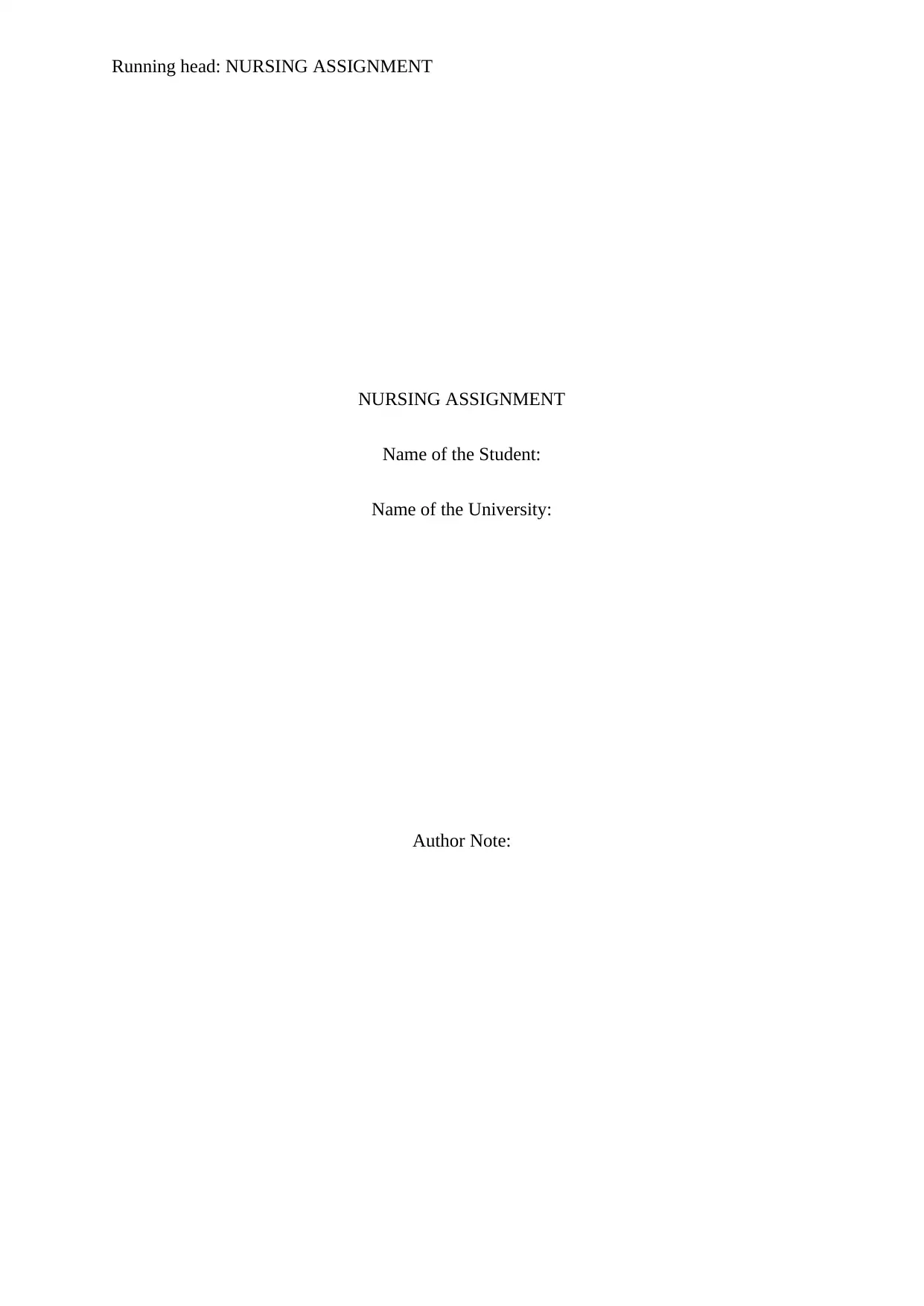
Running head: NURSING ASSIGNMENT
NURSING ASSIGNMENT
Name of the Student:
Name of the University:
Author Note:
NURSING ASSIGNMENT
Name of the Student:
Name of the University:
Author Note:
Secure Best Marks with AI Grader
Need help grading? Try our AI Grader for instant feedback on your assignments.
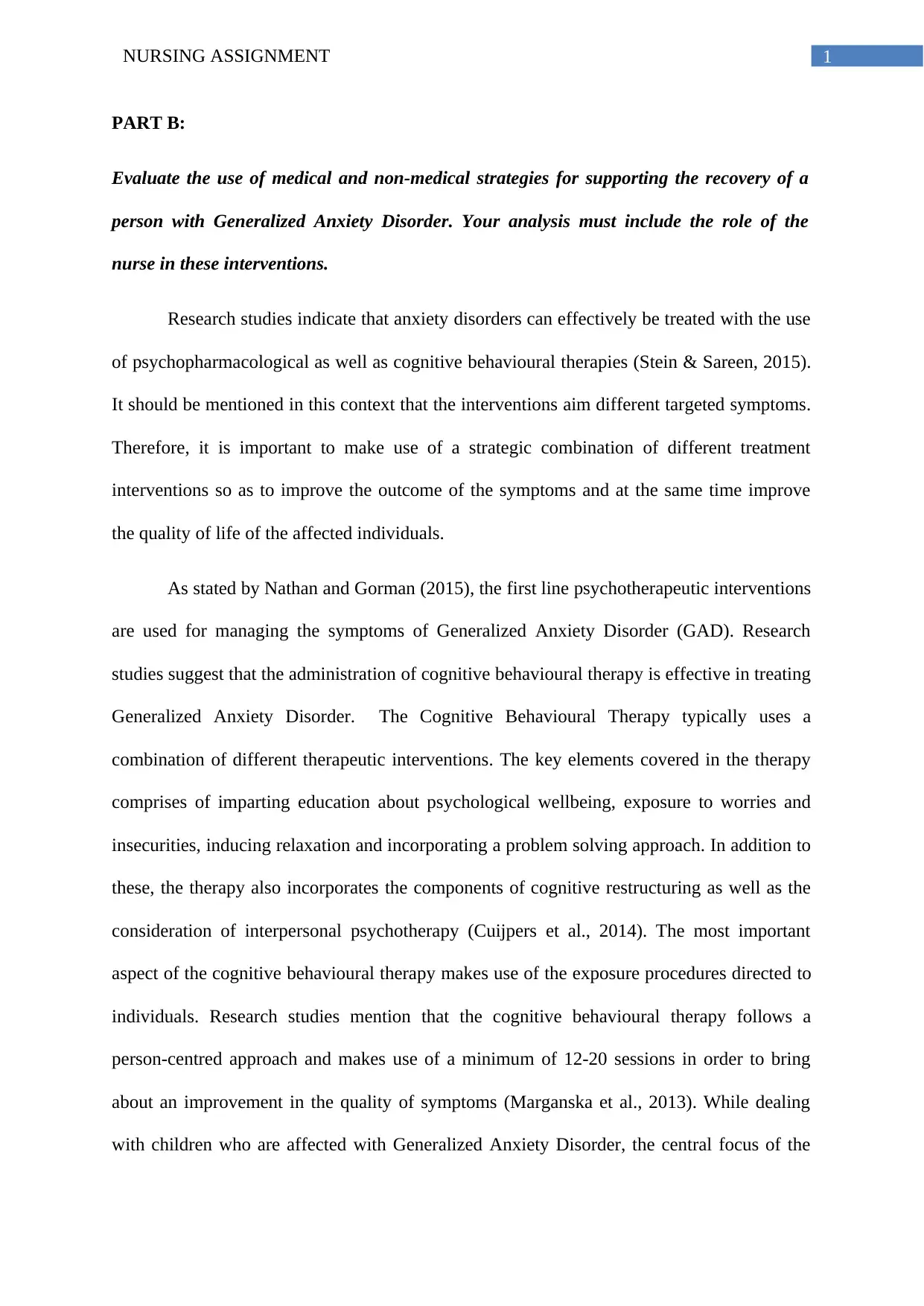
1NURSING ASSIGNMENT
PART B:
Evaluate the use of medical and non-medical strategies for supporting the recovery of a
person with Generalized Anxiety Disorder. Your analysis must include the role of the
nurse in these interventions.
Research studies indicate that anxiety disorders can effectively be treated with the use
of psychopharmacological as well as cognitive behavioural therapies (Stein & Sareen, 2015).
It should be mentioned in this context that the interventions aim different targeted symptoms.
Therefore, it is important to make use of a strategic combination of different treatment
interventions so as to improve the outcome of the symptoms and at the same time improve
the quality of life of the affected individuals.
As stated by Nathan and Gorman (2015), the first line psychotherapeutic interventions
are used for managing the symptoms of Generalized Anxiety Disorder (GAD). Research
studies suggest that the administration of cognitive behavioural therapy is effective in treating
Generalized Anxiety Disorder. The Cognitive Behavioural Therapy typically uses a
combination of different therapeutic interventions. The key elements covered in the therapy
comprises of imparting education about psychological wellbeing, exposure to worries and
insecurities, inducing relaxation and incorporating a problem solving approach. In addition to
these, the therapy also incorporates the components of cognitive restructuring as well as the
consideration of interpersonal psychotherapy (Cuijpers et al., 2014). The most important
aspect of the cognitive behavioural therapy makes use of the exposure procedures directed to
individuals. Research studies mention that the cognitive behavioural therapy follows a
person-centred approach and makes use of a minimum of 12-20 sessions in order to bring
about an improvement in the quality of symptoms (Marganska et al., 2013). While dealing
with children who are affected with Generalized Anxiety Disorder, the central focus of the
PART B:
Evaluate the use of medical and non-medical strategies for supporting the recovery of a
person with Generalized Anxiety Disorder. Your analysis must include the role of the
nurse in these interventions.
Research studies indicate that anxiety disorders can effectively be treated with the use
of psychopharmacological as well as cognitive behavioural therapies (Stein & Sareen, 2015).
It should be mentioned in this context that the interventions aim different targeted symptoms.
Therefore, it is important to make use of a strategic combination of different treatment
interventions so as to improve the outcome of the symptoms and at the same time improve
the quality of life of the affected individuals.
As stated by Nathan and Gorman (2015), the first line psychotherapeutic interventions
are used for managing the symptoms of Generalized Anxiety Disorder (GAD). Research
studies suggest that the administration of cognitive behavioural therapy is effective in treating
Generalized Anxiety Disorder. The Cognitive Behavioural Therapy typically uses a
combination of different therapeutic interventions. The key elements covered in the therapy
comprises of imparting education about psychological wellbeing, exposure to worries and
insecurities, inducing relaxation and incorporating a problem solving approach. In addition to
these, the therapy also incorporates the components of cognitive restructuring as well as the
consideration of interpersonal psychotherapy (Cuijpers et al., 2014). The most important
aspect of the cognitive behavioural therapy makes use of the exposure procedures directed to
individuals. Research studies mention that the cognitive behavioural therapy follows a
person-centred approach and makes use of a minimum of 12-20 sessions in order to bring
about an improvement in the quality of symptoms (Marganska et al., 2013). While dealing
with children who are affected with Generalized Anxiety Disorder, the central focus of the
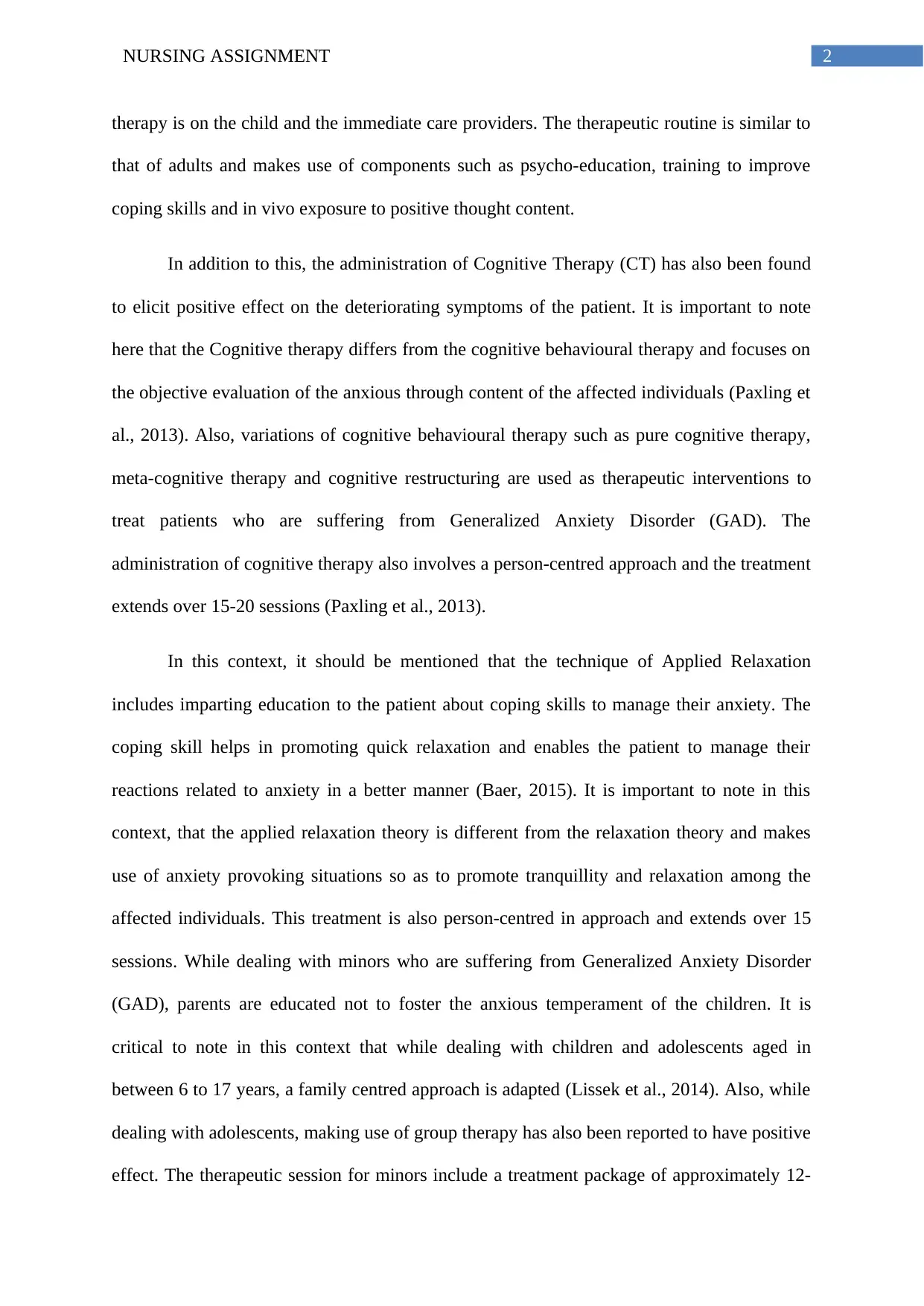
2NURSING ASSIGNMENT
therapy is on the child and the immediate care providers. The therapeutic routine is similar to
that of adults and makes use of components such as psycho-education, training to improve
coping skills and in vivo exposure to positive thought content.
In addition to this, the administration of Cognitive Therapy (CT) has also been found
to elicit positive effect on the deteriorating symptoms of the patient. It is important to note
here that the Cognitive therapy differs from the cognitive behavioural therapy and focuses on
the objective evaluation of the anxious through content of the affected individuals (Paxling et
al., 2013). Also, variations of cognitive behavioural therapy such as pure cognitive therapy,
meta-cognitive therapy and cognitive restructuring are used as therapeutic interventions to
treat patients who are suffering from Generalized Anxiety Disorder (GAD). The
administration of cognitive therapy also involves a person-centred approach and the treatment
extends over 15-20 sessions (Paxling et al., 2013).
In this context, it should be mentioned that the technique of Applied Relaxation
includes imparting education to the patient about coping skills to manage their anxiety. The
coping skill helps in promoting quick relaxation and enables the patient to manage their
reactions related to anxiety in a better manner (Baer, 2015). It is important to note in this
context, that the applied relaxation theory is different from the relaxation theory and makes
use of anxiety provoking situations so as to promote tranquillity and relaxation among the
affected individuals. This treatment is also person-centred in approach and extends over 15
sessions. While dealing with minors who are suffering from Generalized Anxiety Disorder
(GAD), parents are educated not to foster the anxious temperament of the children. It is
critical to note in this context that while dealing with children and adolescents aged in
between 6 to 17 years, a family centred approach is adapted (Lissek et al., 2014). Also, while
dealing with adolescents, making use of group therapy has also been reported to have positive
effect. The therapeutic session for minors include a treatment package of approximately 12-
therapy is on the child and the immediate care providers. The therapeutic routine is similar to
that of adults and makes use of components such as psycho-education, training to improve
coping skills and in vivo exposure to positive thought content.
In addition to this, the administration of Cognitive Therapy (CT) has also been found
to elicit positive effect on the deteriorating symptoms of the patient. It is important to note
here that the Cognitive therapy differs from the cognitive behavioural therapy and focuses on
the objective evaluation of the anxious through content of the affected individuals (Paxling et
al., 2013). Also, variations of cognitive behavioural therapy such as pure cognitive therapy,
meta-cognitive therapy and cognitive restructuring are used as therapeutic interventions to
treat patients who are suffering from Generalized Anxiety Disorder (GAD). The
administration of cognitive therapy also involves a person-centred approach and the treatment
extends over 15-20 sessions (Paxling et al., 2013).
In this context, it should be mentioned that the technique of Applied Relaxation
includes imparting education to the patient about coping skills to manage their anxiety. The
coping skill helps in promoting quick relaxation and enables the patient to manage their
reactions related to anxiety in a better manner (Baer, 2015). It is important to note in this
context, that the applied relaxation theory is different from the relaxation theory and makes
use of anxiety provoking situations so as to promote tranquillity and relaxation among the
affected individuals. This treatment is also person-centred in approach and extends over 15
sessions. While dealing with minors who are suffering from Generalized Anxiety Disorder
(GAD), parents are educated not to foster the anxious temperament of the children. It is
critical to note in this context that while dealing with children and adolescents aged in
between 6 to 17 years, a family centred approach is adapted (Lissek et al., 2014). Also, while
dealing with adolescents, making use of group therapy has also been reported to have positive
effect. The therapeutic session for minors include a treatment package of approximately 12-
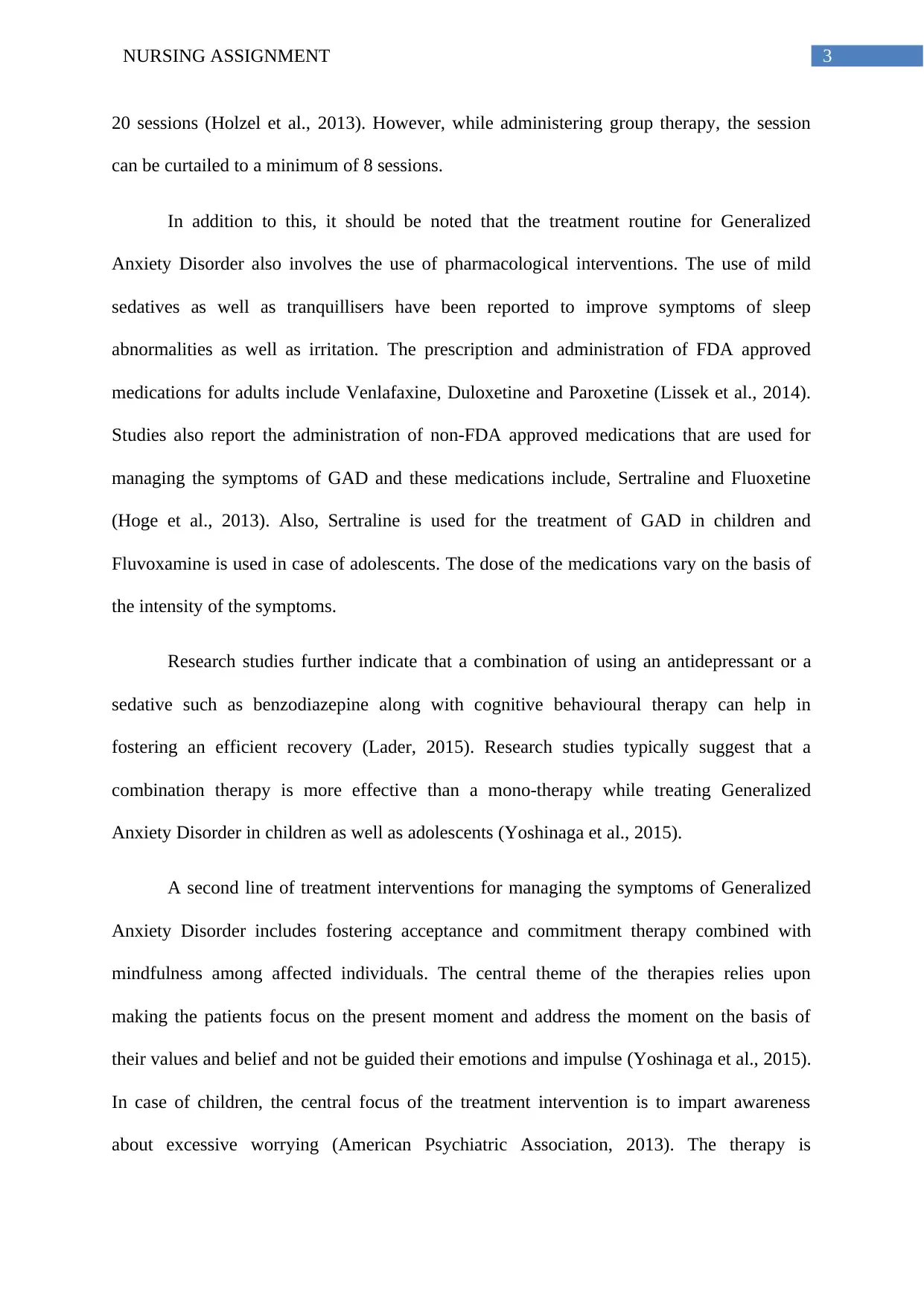
3NURSING ASSIGNMENT
20 sessions (Holzel et al., 2013). However, while administering group therapy, the session
can be curtailed to a minimum of 8 sessions.
In addition to this, it should be noted that the treatment routine for Generalized
Anxiety Disorder also involves the use of pharmacological interventions. The use of mild
sedatives as well as tranquillisers have been reported to improve symptoms of sleep
abnormalities as well as irritation. The prescription and administration of FDA approved
medications for adults include Venlafaxine, Duloxetine and Paroxetine (Lissek et al., 2014).
Studies also report the administration of non-FDA approved medications that are used for
managing the symptoms of GAD and these medications include, Sertraline and Fluoxetine
(Hoge et al., 2013). Also, Sertraline is used for the treatment of GAD in children and
Fluvoxamine is used in case of adolescents. The dose of the medications vary on the basis of
the intensity of the symptoms.
Research studies further indicate that a combination of using an antidepressant or a
sedative such as benzodiazepine along with cognitive behavioural therapy can help in
fostering an efficient recovery (Lader, 2015). Research studies typically suggest that a
combination therapy is more effective than a mono-therapy while treating Generalized
Anxiety Disorder in children as well as adolescents (Yoshinaga et al., 2015).
A second line of treatment interventions for managing the symptoms of Generalized
Anxiety Disorder includes fostering acceptance and commitment therapy combined with
mindfulness among affected individuals. The central theme of the therapies relies upon
making the patients focus on the present moment and address the moment on the basis of
their values and belief and not be guided their emotions and impulse (Yoshinaga et al., 2015).
In case of children, the central focus of the treatment intervention is to impart awareness
about excessive worrying (American Psychiatric Association, 2013). The therapy is
20 sessions (Holzel et al., 2013). However, while administering group therapy, the session
can be curtailed to a minimum of 8 sessions.
In addition to this, it should be noted that the treatment routine for Generalized
Anxiety Disorder also involves the use of pharmacological interventions. The use of mild
sedatives as well as tranquillisers have been reported to improve symptoms of sleep
abnormalities as well as irritation. The prescription and administration of FDA approved
medications for adults include Venlafaxine, Duloxetine and Paroxetine (Lissek et al., 2014).
Studies also report the administration of non-FDA approved medications that are used for
managing the symptoms of GAD and these medications include, Sertraline and Fluoxetine
(Hoge et al., 2013). Also, Sertraline is used for the treatment of GAD in children and
Fluvoxamine is used in case of adolescents. The dose of the medications vary on the basis of
the intensity of the symptoms.
Research studies further indicate that a combination of using an antidepressant or a
sedative such as benzodiazepine along with cognitive behavioural therapy can help in
fostering an efficient recovery (Lader, 2015). Research studies typically suggest that a
combination therapy is more effective than a mono-therapy while treating Generalized
Anxiety Disorder in children as well as adolescents (Yoshinaga et al., 2015).
A second line of treatment interventions for managing the symptoms of Generalized
Anxiety Disorder includes fostering acceptance and commitment therapy combined with
mindfulness among affected individuals. The central theme of the therapies relies upon
making the patients focus on the present moment and address the moment on the basis of
their values and belief and not be guided their emotions and impulse (Yoshinaga et al., 2015).
In case of children, the central focus of the treatment intervention is to impart awareness
about excessive worrying (American Psychiatric Association, 2013). The therapy is
Secure Best Marks with AI Grader
Need help grading? Try our AI Grader for instant feedback on your assignments.
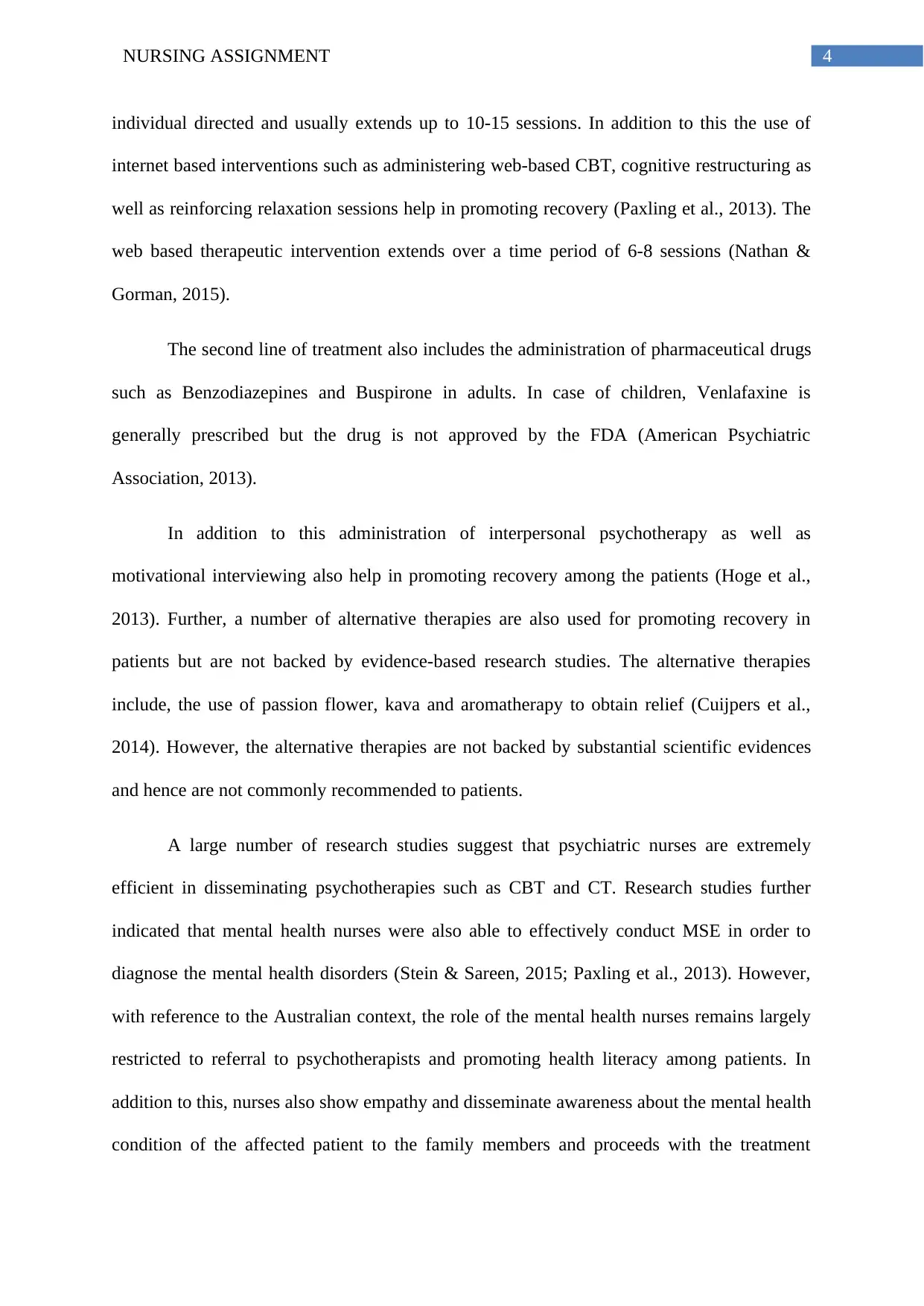
4NURSING ASSIGNMENT
individual directed and usually extends up to 10-15 sessions. In addition to this the use of
internet based interventions such as administering web-based CBT, cognitive restructuring as
well as reinforcing relaxation sessions help in promoting recovery (Paxling et al., 2013). The
web based therapeutic intervention extends over a time period of 6-8 sessions (Nathan &
Gorman, 2015).
The second line of treatment also includes the administration of pharmaceutical drugs
such as Benzodiazepines and Buspirone in adults. In case of children, Venlafaxine is
generally prescribed but the drug is not approved by the FDA (American Psychiatric
Association, 2013).
In addition to this administration of interpersonal psychotherapy as well as
motivational interviewing also help in promoting recovery among the patients (Hoge et al.,
2013). Further, a number of alternative therapies are also used for promoting recovery in
patients but are not backed by evidence-based research studies. The alternative therapies
include, the use of passion flower, kava and aromatherapy to obtain relief (Cuijpers et al.,
2014). However, the alternative therapies are not backed by substantial scientific evidences
and hence are not commonly recommended to patients.
A large number of research studies suggest that psychiatric nurses are extremely
efficient in disseminating psychotherapies such as CBT and CT. Research studies further
indicated that mental health nurses were also able to effectively conduct MSE in order to
diagnose the mental health disorders (Stein & Sareen, 2015; Paxling et al., 2013). However,
with reference to the Australian context, the role of the mental health nurses remains largely
restricted to referral to psychotherapists and promoting health literacy among patients. In
addition to this, nurses also show empathy and disseminate awareness about the mental health
condition of the affected patient to the family members and proceeds with the treatment
individual directed and usually extends up to 10-15 sessions. In addition to this the use of
internet based interventions such as administering web-based CBT, cognitive restructuring as
well as reinforcing relaxation sessions help in promoting recovery (Paxling et al., 2013). The
web based therapeutic intervention extends over a time period of 6-8 sessions (Nathan &
Gorman, 2015).
The second line of treatment also includes the administration of pharmaceutical drugs
such as Benzodiazepines and Buspirone in adults. In case of children, Venlafaxine is
generally prescribed but the drug is not approved by the FDA (American Psychiatric
Association, 2013).
In addition to this administration of interpersonal psychotherapy as well as
motivational interviewing also help in promoting recovery among the patients (Hoge et al.,
2013). Further, a number of alternative therapies are also used for promoting recovery in
patients but are not backed by evidence-based research studies. The alternative therapies
include, the use of passion flower, kava and aromatherapy to obtain relief (Cuijpers et al.,
2014). However, the alternative therapies are not backed by substantial scientific evidences
and hence are not commonly recommended to patients.
A large number of research studies suggest that psychiatric nurses are extremely
efficient in disseminating psychotherapies such as CBT and CT. Research studies further
indicated that mental health nurses were also able to effectively conduct MSE in order to
diagnose the mental health disorders (Stein & Sareen, 2015; Paxling et al., 2013). However,
with reference to the Australian context, the role of the mental health nurses remains largely
restricted to referral to psychotherapists and promoting health literacy among patients. In
addition to this, nurses also show empathy and disseminate awareness about the mental health
condition of the affected patient to the family members and proceeds with the treatment
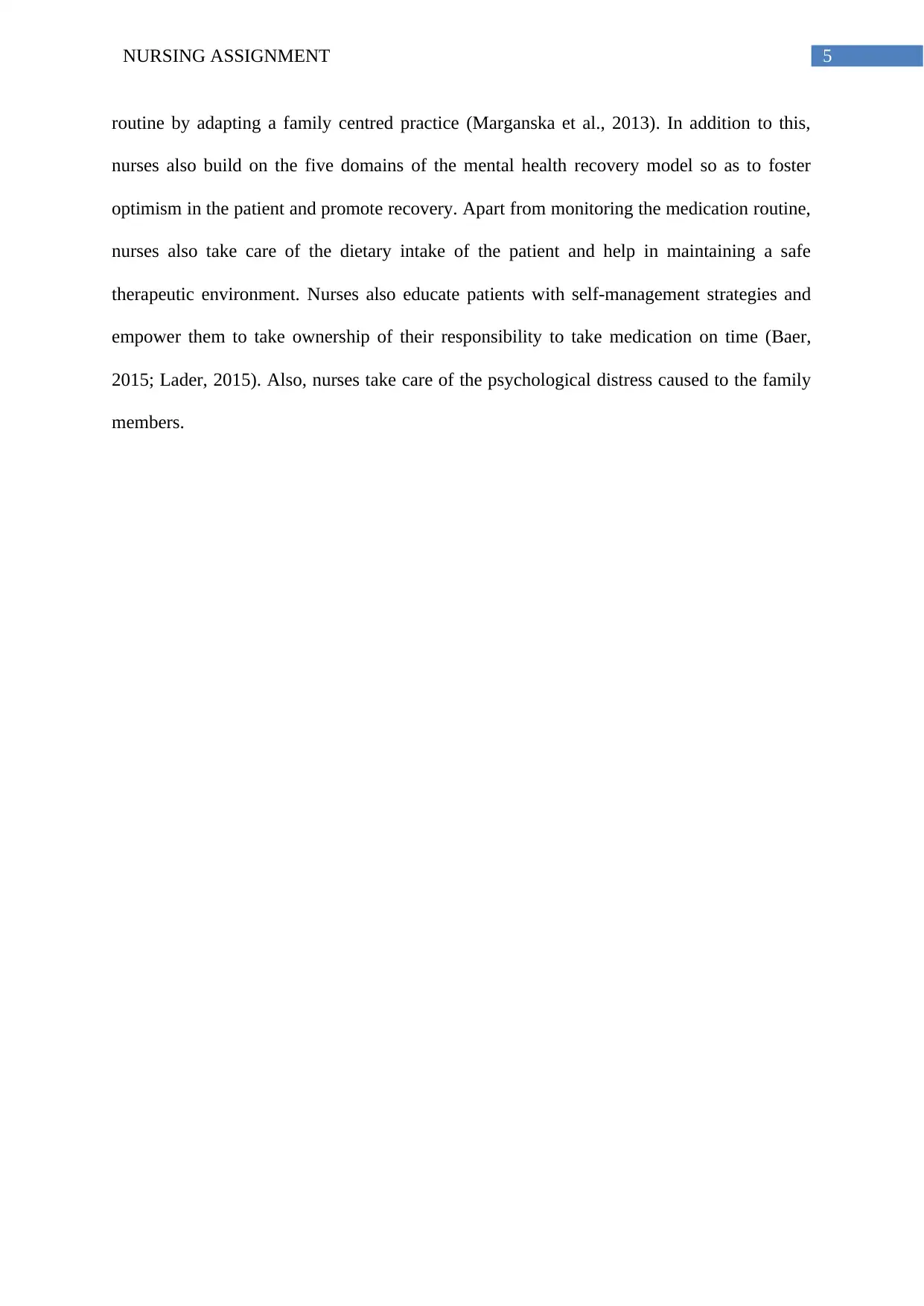
5NURSING ASSIGNMENT
routine by adapting a family centred practice (Marganska et al., 2013). In addition to this,
nurses also build on the five domains of the mental health recovery model so as to foster
optimism in the patient and promote recovery. Apart from monitoring the medication routine,
nurses also take care of the dietary intake of the patient and help in maintaining a safe
therapeutic environment. Nurses also educate patients with self-management strategies and
empower them to take ownership of their responsibility to take medication on time (Baer,
2015; Lader, 2015). Also, nurses take care of the psychological distress caused to the family
members.
routine by adapting a family centred practice (Marganska et al., 2013). In addition to this,
nurses also build on the five domains of the mental health recovery model so as to foster
optimism in the patient and promote recovery. Apart from monitoring the medication routine,
nurses also take care of the dietary intake of the patient and help in maintaining a safe
therapeutic environment. Nurses also educate patients with self-management strategies and
empower them to take ownership of their responsibility to take medication on time (Baer,
2015; Lader, 2015). Also, nurses take care of the psychological distress caused to the family
members.
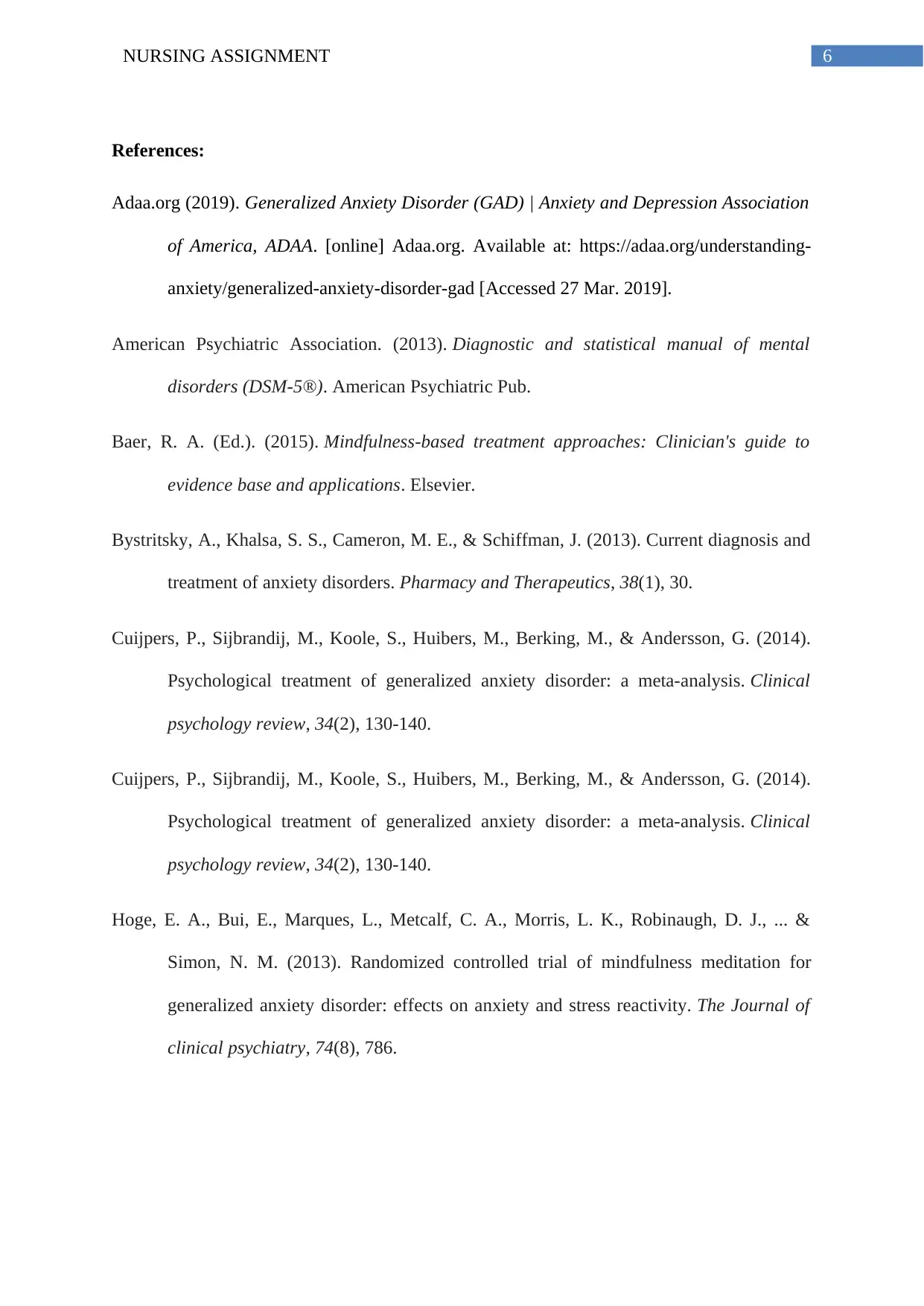
6NURSING ASSIGNMENT
References:
Adaa.org (2019). Generalized Anxiety Disorder (GAD) | Anxiety and Depression Association
of America, ADAA. [online] Adaa.org. Available at: https://adaa.org/understanding-
anxiety/generalized-anxiety-disorder-gad [Accessed 27 Mar. 2019].
American Psychiatric Association. (2013). Diagnostic and statistical manual of mental
disorders (DSM-5®). American Psychiatric Pub.
Baer, R. A. (Ed.). (2015). Mindfulness-based treatment approaches: Clinician's guide to
evidence base and applications. Elsevier.
Bystritsky, A., Khalsa, S. S., Cameron, M. E., & Schiffman, J. (2013). Current diagnosis and
treatment of anxiety disorders. Pharmacy and Therapeutics, 38(1), 30.
Cuijpers, P., Sijbrandij, M., Koole, S., Huibers, M., Berking, M., & Andersson, G. (2014).
Psychological treatment of generalized anxiety disorder: a meta-analysis. Clinical
psychology review, 34(2), 130-140.
Cuijpers, P., Sijbrandij, M., Koole, S., Huibers, M., Berking, M., & Andersson, G. (2014).
Psychological treatment of generalized anxiety disorder: a meta-analysis. Clinical
psychology review, 34(2), 130-140.
Hoge, E. A., Bui, E., Marques, L., Metcalf, C. A., Morris, L. K., Robinaugh, D. J., ... &
Simon, N. M. (2013). Randomized controlled trial of mindfulness meditation for
generalized anxiety disorder: effects on anxiety and stress reactivity. The Journal of
clinical psychiatry, 74(8), 786.
References:
Adaa.org (2019). Generalized Anxiety Disorder (GAD) | Anxiety and Depression Association
of America, ADAA. [online] Adaa.org. Available at: https://adaa.org/understanding-
anxiety/generalized-anxiety-disorder-gad [Accessed 27 Mar. 2019].
American Psychiatric Association. (2013). Diagnostic and statistical manual of mental
disorders (DSM-5®). American Psychiatric Pub.
Baer, R. A. (Ed.). (2015). Mindfulness-based treatment approaches: Clinician's guide to
evidence base and applications. Elsevier.
Bystritsky, A., Khalsa, S. S., Cameron, M. E., & Schiffman, J. (2013). Current diagnosis and
treatment of anxiety disorders. Pharmacy and Therapeutics, 38(1), 30.
Cuijpers, P., Sijbrandij, M., Koole, S., Huibers, M., Berking, M., & Andersson, G. (2014).
Psychological treatment of generalized anxiety disorder: a meta-analysis. Clinical
psychology review, 34(2), 130-140.
Cuijpers, P., Sijbrandij, M., Koole, S., Huibers, M., Berking, M., & Andersson, G. (2014).
Psychological treatment of generalized anxiety disorder: a meta-analysis. Clinical
psychology review, 34(2), 130-140.
Hoge, E. A., Bui, E., Marques, L., Metcalf, C. A., Morris, L. K., Robinaugh, D. J., ... &
Simon, N. M. (2013). Randomized controlled trial of mindfulness meditation for
generalized anxiety disorder: effects on anxiety and stress reactivity. The Journal of
clinical psychiatry, 74(8), 786.
Paraphrase This Document
Need a fresh take? Get an instant paraphrase of this document with our AI Paraphraser

7NURSING ASSIGNMENT
Hölzel, B. K., Hoge, E. A., Greve, D. N., Gard, T., Creswell, J. D., Brown, K. W., ... &
Lazar, S. W. (2013). Neural mechanisms of symptom improvements in generalized
anxiety disorder following mindfulness training. NeuroImage: Clinical, 2, 448-458.
Lader, M. (2015). Generalized anxiety disorder. Encyclopedia of psychopharmacology, 699-
702.
Lissek, S., Kaczkurkin, A. N., Rabin, S., Geraci, M., Pine, D. S., & Grillon, C. (2014).
Generalized anxiety disorder is associated with overgeneralization of classically
conditioned fear. Biological psychiatry, 75(11), 909-915.
Marganska, A., Gallagher, M., & Miranda, R. (2013). Adult attachment, emotion
dysregulation, and symptoms of depression and generalized anxiety
disorder. American Journal of Orthopsychiatry, 83(1), 131.
Nathan, P. E., & Gorman, J. M. (Eds.). (2015). A guide to treatments that work. Oxford
University Press.P.90
Paxling, B., Lundgren, S., Norman, A., Almlöv, J., Carlbring, P., Cuijpers, P., & Andersson,
G. (2013). Therapist behaviours in internet-delivered cognitive behaviour therapy:
analyses of e-mail correspondence in the treatment of generalized anxiety
disorder. Behavioural and cognitive psychotherapy, 41(3), 280-289.
Stein, M. B., & Sareen, J. (2015). Generalized anxiety disorder. New England Journal of
Medicine, 373(21), 2059-2068.
Yoshinaga, N., Nosaki, A., Hayashi, Y., Tanoue, H., Shimizu, E., Kunikata, H., ... &
Shiraishi, Y. (2015). Cognitive behavioral therapy in psychiatric nursing in
Japan. Nursing research and practice, 2015.
Hölzel, B. K., Hoge, E. A., Greve, D. N., Gard, T., Creswell, J. D., Brown, K. W., ... &
Lazar, S. W. (2013). Neural mechanisms of symptom improvements in generalized
anxiety disorder following mindfulness training. NeuroImage: Clinical, 2, 448-458.
Lader, M. (2015). Generalized anxiety disorder. Encyclopedia of psychopharmacology, 699-
702.
Lissek, S., Kaczkurkin, A. N., Rabin, S., Geraci, M., Pine, D. S., & Grillon, C. (2014).
Generalized anxiety disorder is associated with overgeneralization of classically
conditioned fear. Biological psychiatry, 75(11), 909-915.
Marganska, A., Gallagher, M., & Miranda, R. (2013). Adult attachment, emotion
dysregulation, and symptoms of depression and generalized anxiety
disorder. American Journal of Orthopsychiatry, 83(1), 131.
Nathan, P. E., & Gorman, J. M. (Eds.). (2015). A guide to treatments that work. Oxford
University Press.P.90
Paxling, B., Lundgren, S., Norman, A., Almlöv, J., Carlbring, P., Cuijpers, P., & Andersson,
G. (2013). Therapist behaviours in internet-delivered cognitive behaviour therapy:
analyses of e-mail correspondence in the treatment of generalized anxiety
disorder. Behavioural and cognitive psychotherapy, 41(3), 280-289.
Stein, M. B., & Sareen, J. (2015). Generalized anxiety disorder. New England Journal of
Medicine, 373(21), 2059-2068.
Yoshinaga, N., Nosaki, A., Hayashi, Y., Tanoue, H., Shimizu, E., Kunikata, H., ... &
Shiraishi, Y. (2015). Cognitive behavioral therapy in psychiatric nursing in
Japan. Nursing research and practice, 2015.
1 out of 8
Related Documents
Your All-in-One AI-Powered Toolkit for Academic Success.
+13062052269
info@desklib.com
Available 24*7 on WhatsApp / Email
![[object Object]](/_next/static/media/star-bottom.7253800d.svg)
Unlock your academic potential
© 2024 | Zucol Services PVT LTD | All rights reserved.





